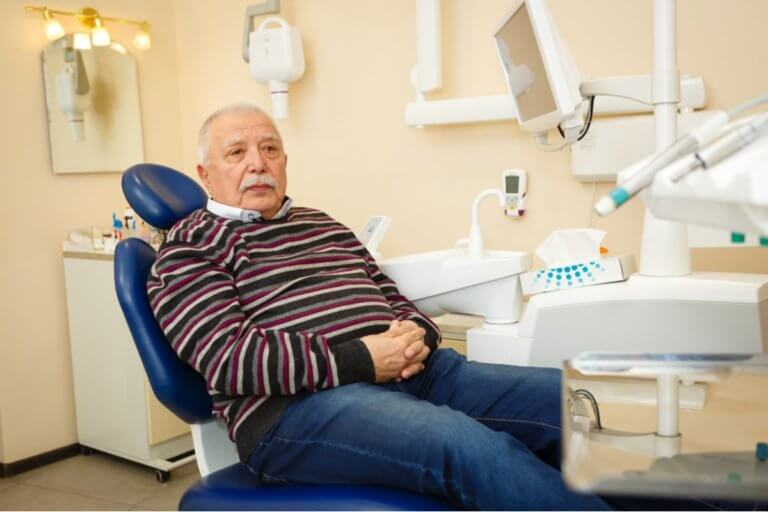As some people age, it is not uncommon to experience the shortening and or the discoloration of teeth. Let’s explore the causes and potential solutions to this unsightly problem.
Can You Cover My Brown Teeth?
Such a seemingly simple problem which can be corrected by a simple solution. We talk about modern materials and techniques all the time. Wouldn’t it be simple to and easy to mask unsightly teeth?
Background of our Case
Allow me to describe the situation in a little more detail. The patient that asked me this question had seven lower teeth across the front of his mouth. He had no back teeth. He wore a bridge that came in and out for him. On his upper jaw, he had a combination of natural teeth, bridgework on implants and other bridgework on natural teeth. Unlike the lower jaw, he did not have any artificial back teeth on the upper jaw.
As we get older, we see more of the lower teeth. In his case, the lower teeth were not only more visible, but they were very short. Short teeth with more visibility are a perfect combination for disaster.
Why do teeth get shorter?
We get shorter as we age. This is due to spinal compression. Similarly, our teeth get shorter as they wear and grind against each other. The enamel covering over the tooth will wear away as the teeth chew. Once the enamel wears away totally, the underlying dentin appears.
Dentin is softer than enamel and as a result, will stain easier. All of this results in the shortening and discoloration of teeth. The front teeth are not made for grinding like the back teeth.
In those cases where there are no or few back teeth, the front teeth need to get into the act. They start to do a job for which they were never intended. They help with the grinding of food. This unintended job of grinding food results in faster wear and deterioration of the top of the tooth. Before you know it the tooth is much shorter than it ever was and the top portion turns brown. All you have to do is open your mouth and it glares you in the face so to speak.
Remedying the Situation
If we get back to our original question of how to fix this problem, the first request is to simply cover the top of the teeth with a bonding material. It’s a great idea in theory, but practically it won’t work.
Our teeth are the hardest structure that exists in the human body. Yet we see that it will wear away with daily chewing and grinding. The materials that we use for bonding are not that strong. They will not hold up to this type of wear and tear. This makes them a poor choice as a long term solution for short and brown teeth.
If we can build up the teeth at the back of the mouth so that we can’t grind with the front teeth, then we have a fighting chance of this working. The back teeth can be built up with porcelain or zirconia which are made by the dental laboratory. Then the bonding solution will work.
However, we must remember that in our case this week, the patient did not have his own teeth. He had a removable bridge.This could be built up for the short term, but this would wear down very quickly.
The easiest solution for the worn and discolored lower front teeth is a crown procedure. It is fast and predictable. Start to finish would take weeks rather than months and could be done in a week or two with just two appointments.
Summarizing our Solution Options
So to summarize our solution if we have strong back teeth, then bonding could be a potential short term fix. If we have no back teeth or want something to last longer utilizing crowns or caps would be the treatment of choice.
If you are not happy when you open your mouth and see unsightly discoloration of teeth, please call Megan and 440.951.7856 and set up a visit to discuss this situation. You are not alone, and easy treatment is within your grasp. I do not charge you when we explore possibilities. What do you have to lose? I look forward to meeting you.
Jeffrey Gross, DDS, FAGD is an Ohio licensed general dentist and is on the staff of Case Western Reserve School of Dental Medicine.

